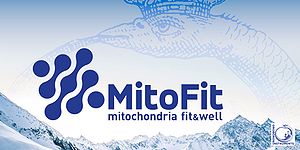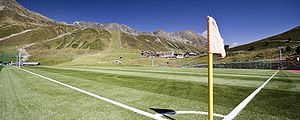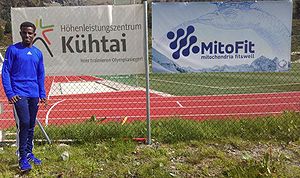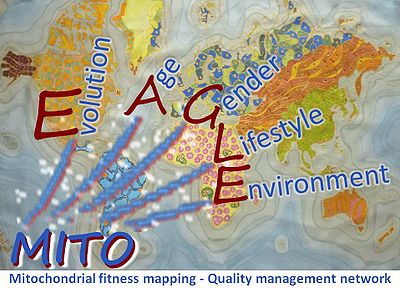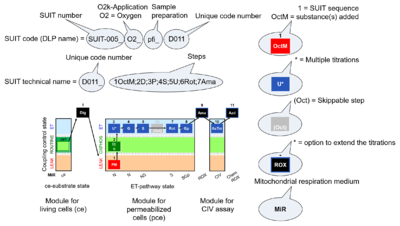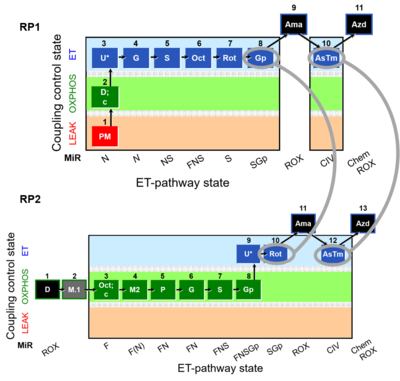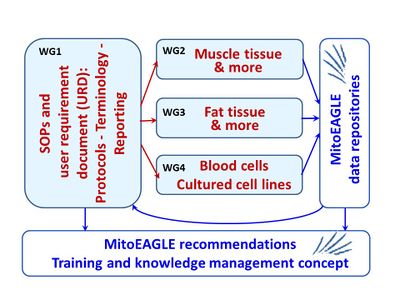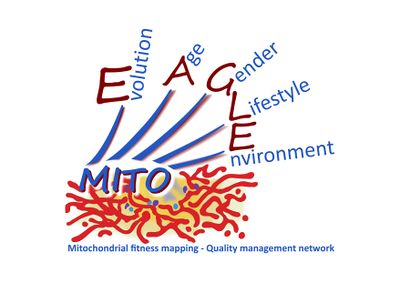Difference between revisions of "MitoFit Science Camp 2016 Kuehtai AT"
| Line 221: | Line 221: | ||
: '''09:00-10:15''' | : '''09:00-10:15''' | ||
:::: * Oxygen dependence of H2O2 release from skeletal muscle and cardiac mitochondria: influence of sample preparation. ([[Chicco 2016a Abstract MitoFit Science Camp 2016 |'''Chicco AJ''', Hedges MR, Rasicci DV, Specht KS]]) | ::::* Oxygen dependence of H2O2 release from skeletal muscle and cardiac mitochondria: influence of sample preparation. ([[Chicco 2016a Abstract MitoFit Science Camp 2016 |'''Chicco AJ''', Hedges MR, Rasicci DV, Specht KS]]) | ||
::::* Technical perspective of high-resolution respirometry in permeabilized skinned muscle fibers from different mouse models. ([[Garcia-Roves 2016b Abstract MitoFit Science Camp 2016 |Gama-Perez P, Moreno S, Gonzalez-Franquesa A, '''Garcia-Roves PM''']]) | |||
: '''10:45-12:00''' | : '''10:45-12:00''' | ||
::::* Investigating the mechanism of cardiac mitochondrial respiratory impairment in Barth Syndrome. ([[Chicco 2016c Abstract MitoFit Science Camp 2016 |'''Chicco AJ''', Le CH, Benage LG, Prenni JE, Heuberger AL]]) | |||
::: '''''Further details''''' | ::: '''''Further details''''' | ||
| Line 245: | Line 246: | ||
: '''09:00-10:15''' | : '''09:00-10:15''' | ||
::::* Design and implementation of systems biology approaches to integrate heterogenic data in biomedical research. ([[Garcia-Roves 2016a Abstract MitoFit Science Camp 2016 | | |||
Gonzalez-Franquesa A, Gama-Perez P, Aguilar A, Yanes O, Martin-Subero JI, Sales-Pardo M, Guimera R, '''Garcia-Roves PM''']]) | |||
: '''10:45-12:00''' | : '''10:45-12:00''' | ||
| Line 280: | Line 284: | ||
: '''09:00-10:15''' | : '''09:00-10:15''' | ||
:::: | ::::* A supervised statistical approach: about the meaning of the mean and beyond in small sample sizes. ([[Goebel G |Georg Göbel]]) | ||
:::: 10:00 The [[MITOEAGLE network]]. | :::: 10:00 The [[MITOEAGLE network]]. | ||
:::: 10:00 IOC112 O2k-Workshop - experimental working groups. | :::: 10:00 IOC112 O2k-Workshop - experimental working groups. | ||
Revision as of 13:17, 28 June 2016
MitoFit Science Camp 2016 Kuehtai AT
|
Kuehtai AT, 2016 Jul 07-13. MitoFit Science Camp and IOC112. |
» MitoFit
OROBOROS (2016-07-07) MitoGlobal
Abstract: 2016 Jul 07-13, Kuehtai, AT. The project MitoFit aims at developing novel laboratory standards and diagnostic monitoring of a mitochondrial fitness score. With an international team of outstanding mitochondrial experts, the MitoFit Science Camp will provide a unique opportunity to receive first-hand introductions to state-of-the-art diagnostic monitoring of mitochondrial respiratory function combined with hands-on training on HRR (IOC112). Diverse areas are covered such as protective medicine, exercise physiology, mitochondrial pharmacology, aging, and comparative mitochondrial physiology (cell types, tissues, species). The common focus is on methodology, experimental details and quality control. The MitoFit Science Camp may be considered as a sequence of workshops rather than a conference or school, addressing key topics of the COST Action MITOEAGLE project. This will provide a key opportunity to prepare the 1st Management Committee Meeting. To express the concept of this student- and research-oriented event more directly, the term MitoFit Science Camp replaced the former MitoFit Training Camp.
• O2k-Network Lab: AT Innsbruck OROBOROS
Labels: MiParea: mt-Awareness
2016, ORO, IOC, O2k-Network, MitoFit, Next
- MitoFit Science Camp - for and with mitochondrial scientists
News
- » Circular 2016-06-27: Programme structure day 2 and Science Camp format
- » Last-minute registrations are still possible: MitoFit SC 2016 Registration.
- » Circular 2016-06-15: MITOEAGLE data repository in muscle tissues
- » MitoFit Science Camp 2016 Kuehtai AT: Abstracts - alphabetical order
Date, venue, sports programme
Date
- 2016, July 07-13
- Immediately following EBEC2016 (July 2-7) organized by Paolo Bernardi in Riva del Garda (2.5 hours from Innsbruck).
Venue
- High Altitude Training Center Kühtai, Kuehtai (Tyrol, Austria), 2020 m a.s.l. (42 min from Innsbruck).
Scientific sessions
- Sporthotel Kühtai
- A-6183 Kühtai • Nr. 9
- www.sporthotel-kuehtai.com
Accommodation, breakfast and dinner
- Hotel Astoria
- A-6183 Kühtai • Nr. 33
- Tel.: +43 5239-5215 • Fax: +43 5239-5215-80 • Mail [email protected]
- www.hotelastoria.at
- Additional accomodation: sourrounding apartments/hotels.
Sport programme
- Activities at the participant's own risk. Sport programme is offered in collaboration with the Institute of Sport Science (University Innsbruck), Sporttherapie Huber, and the High Altitude Training Centre Kühtai.
- Sign in as a subject: spiroergometric tests (limited number of participants).
- MitoFit: expertise by experience - high altitude sports and physiotherapy in the Kuehtai environment.
 » http://www.hoehentraining-kuehtai.at/
» http://www.hoehentraining-kuehtai.at/ » http://www.sporttherapie-huber.at
» http://www.sporttherapie-huber.at- » Meet the MitoFit athlete: a unique training experience
- » Meet the MitoFit expert: groups and one-on-one sessions
- » Walks&Talks
Participants and abstracts
- List of participants, abstract guidelines and abstracts received:
Preliminary programme
- 1A: Diagnostic substrate-uncoupler-inhibitor titration (SUIT) protocols of mitochondrial fitness.
- 1B: Quality management system for mitochondrial respirometry: the MitoFit proficiency test with a real-time Demo-Experiment (SUIT reference protocol).
- 2A: Mitochondrial assays in blood cells: Blood cell preparation, cryopreservation, respiration.
- 2B: Cell culture models versus tissue samples: - Brain and neuronal cells - Adipose tissue - Other
- 3A: Skeletal and cardiac muscle fibres - towards a data repository.
- Working groups will be defined for the following topics: hyperoxic vs. normoxic, media, buffers, preparational assays, dry weight vs. wet weight, normalization (tissue vs. mt-markers; flux control ratios; flux control factors; statistical critique of RCR), quality control and nomenclature.
- 3B: Excursion.
- 3A: Skeletal and cardiac muscle fibres - towards a data repository.
- 4A: Towards a database on mt-respiratory physiology: from laboratory standards to inter-laboratory harmonization.
- 4B: Mitochondrial health: from molecules, cells and tissues - to the body and mind.
- IOC112:
- 5A: Experimental working groups on cell and mitochondrial preparations: cell membrane permeabilization, tissue homogenate preparation, isolation of mitochondria, tissue permeabilization.
- 5B: Experimental working groups on cells and tissues: cell culture, skeletal muscle, cardiac tissue, brain tissue and cells, adipose tissue and cells.
July 07 Th 08 Fr 09 Sa 10 Su 11 Mo 12 Tu 13 We 07:00-08:00 Arrival Morning Action Morning Action Morning Action Morning Action 08:00-09:00 Break(fast) Break(fast) Break(fast) Break(fast) Break(fast) Breakfast 09:00-10:15 Topic 1A Topic 2A Topic 3A Topic 4A Topic 5A Departure 10:45-12:00 12:00-15:00 Lunch & Action Lunch & Action Excursion Lunch & Action Lunch & Action 15:30-16:45 Topic 1B Topic 2B Topic 4B Topic 5B 17:15-18:30 19:00-20:30 Dinner Dinner Dinner Dinner Dinner Dinner 20:30-21:15 1C: Evening topic 2C: Evening topic Keynote (starts at 20:15)
European-Championship public viewingMITOEAGLE and MoTrPAC MitoFit party
- Topics are scheduled as a sequence of workshops to merge introductory lectures, panels, and poster flashes.
- High-resolution respirometry (HRR) will be demonstrated at various levels, integrating an IOC (O2k-Workshop on HRR) into the MitoFit Science Camp, with an emphasis on instrumental quality control - towards MitoFit Proficiency Testing. DatLab 7 will be released and introduced as the software for quality control in HRR.
- The programme is designed as a global introduction to the perspectives of the COST Action MITOEAGLE.
- MITOEAGLE theme
- MITOEAGLE aims at providing the first standardized measures to link mitochondrial and physiome performance (heart rate, BMI, blood pressure, blood chemistry, VO2max) to understand the myriad of factors that play a role in mitochondrial physiology. The ambitious objective to optimally harmonize protocols across research groups cannot be achieved through projects with limited numbers of partners. Therefore, the COST framework represents an ideal instrument which allows bringing together many groups and experts in the diverse field of mitochondrial physiology. The aim of this Action is to form a unique well-coordinated network of senior researchers and young investigators, to include well established stakeholders, and to establish a spirit of mentorship and collaboration in contrast to fierce competition which characterized early decades of bioenergetics. The COST Action MITOEAGLE aims at developing a quality management system (QMS), defining common standards for measurements in the field of mitochondrial function.- MITOEAGLE may be seen as too ambitious in the short term, but indispensable at large.
- MITOEAGLE theme
- Increase the value and reduce the noise
- Enthusiastic and authentic opinion leaders can bring about a change to increase the value and reduce the noise in mitochondrial research specifically, biomedicine at large, and in our society in general. Millions of Euros are wasted on research that is lacking coherent standards. Prespecified and time-stamped protocols are needed, and researchers need to be introduced into adhering to publicly deposited protocols in practice (Begley, Ioannidis 2015). MITOEAGLE recommendations will provide practical guidelines for students, scientists and stakeholders.
- Increase the value and reduce the noise
- Further details: MITOEAGLE
1A: Diagnostic SUIT protocols of mitochondrial fitness
- MitoPedia: SUIT
- A ‘library of SUIT protocols’ applied in mitochondrial respiratory physiology is collected in a standard format, delineating the diversity of experimental approaches to assess bioenergetic function. A set of reference protocols and validated standard protocols will rigorously document (Maelstrom Research program) the state-of-the-art in designing, conducting, reporting, interpreting, and validating such bioenergetic tests.
- MitoPedia: SUIT
- 09:00-10:15 SUIT protocols: the next steps
- SUIT protocols - MitoPathways 2007-2016 (Gnaiger E)
- 10:45-12:00 SUIT protocols: limitations and solutions
- Suitability of octanoylcarnitine & malate for assessment of beta oxidation capacity by respirometry in aconitase-inhibited samples. (Osiki PO, Ojuka E)
- Further details: MITOEAGLE protocols, terminology, documentation
1B: Quality management system for mitochondrial respirometry: the MitoFit proficiency test
- Quality management system (QMS)
- The quality of any database is not better than the quality of the primary constituent datasets. Rigorous standards have to be applied to forge information into knowledge. Comparability of data generated by different labs on OXPHOS performance is restricted due to different laboratory protocols applied. Harmonization is clearly required along these lines, including the establishment of mitochondrial reference samples for inter-laboratory proficiency tests, and guidelines for data analysis and reporting (http://www.equator-network.org/).
- Quality management system (QMS)
- There is no QMS commonly available in the field of mitochondrial respirometry and bioenergetics. Without networking on a large scale it is not possible to implement a widely or even generally accepted set of standards that is required for harmonization of datasets.
- Interlaboratory proficiency test
- Inter-laboratory ring tests are a basic requirement for quality management. Such proficiency tests require a reference sample which must be homogenous, stable, representative of the diagnostic target, amenable for distribution, and economical for large-scale production. For respiratory OXPHOS analysis a reference sample of structurally and functionally intact mitochondria is not yet available to perform corresponding ring tests (in contrast to enzymatic OXPHOS ring tests). Recently, the widely applied human cell line HEK 293T was found to be potentially suitable for cryopreservation. Upon thawing the cells can be used immediately for respirometry of both intact and permeabilized cells. Thus interlaboratory proficiency testing may now be feasible as a world-wide innovation in the field of mitochondrial respiratory physiology. Participating labs may implement the test for intra- and interlaboratory validation and longitudinal performance monitoring, using a SUIT reference protocol. Feedback from the participants will lead to adjustments of the SOPs in the proficiency test, which will be made generally available.
- Comparison of results between and within instrumental platforms: The reference protocols and proficiency test will not define the instrumental platform, but will allow a quantitative comparison of results obtained with specific equipment available in the participating laboratories.
- From standardization to harmonization: MitoPedia
- The logistics of development of a database requires application of strictly defined terms for all included variables. There is no general reference available upon which a consistent terminology on mitochondrial physiology and bioenergetics can be based. The MITOEAGLE consortium, therefore, has to accomplish the ambitious goal to unify and simplify the terminology in the field for the purpose of the QMS, which will lead to the development of recommendations for the use of a common terminology in mitochondrial physiological research. A publication will be prepared as an Open Access article which will be a milestone towards a unification of concepts and nomenclature.
- MITOEAGLE will elaborate definitions of fundamental terms as required by the data management system, including a review on normalization of the data (tissue mass, cell protein, mt-markers such as mt-volume, mt-protein, mt-marker enzymes, flux ratios).
- From standardization to harmonization: MitoPedia
- 15:30-16:45
- 17:15-18:30
- Further details on WG1:
1C: MITOEAGLE Nomenclature
- Harmonization of nomenclature on mitochondrial respiratory states and control parameters: The logistics of development of a database requires application of strictly defined terms for all included variables. There is no general reference available upon which a consistent terminology on mitochondrial physiology and bioenergetics can be based. The MITOEAGLE consortium, therefore, has to accomplish the ambitious goal to unify and simplify the terminology in the field for the purpose of the QMS, which will lead to the development of recommendations for the use of a common terminology in mitochondrial physiological research. A publication will be prepared as an Open Access article which will be a milestone towards a unification of concepts and nomenclature.
- » Do bioenergetics and mitochondrial physiology need a consistent nomenclature to become MitoFit?
- » Can an expanded 'MitoPedia' provide a basis for a joint publication on 'unification of concepts and nomenclature'?
2A: Mitochondrial assays in blood cells
- Biopsy sampling of human muscle and fat tissue for mitochondrial studies is an invasive approach. More recently measurement of mitochondrial function in human blood cells – as well as temporary cryopreservation (Karabatsiakis 2014 Translational Psychiatry) – has become an attractive and by far less invasive alternative for mitochondrial diagnostics. Mitochondrial function of blood cells was linked with numerous diseases and metabolic conditions such as sepsis, neurodegenerative diseases, depression, hypertension, amyotrophic lateral sclerosis, and early-stage heart failure (e.g. Sjoevall 2013 Crit Care; Karabatsiakis 2014 Translational Psychiatry; Hagl 2014 J Alzheimers Dis). The use of human blood cells will thus predictably widen the applicability of respirometry in human physiology and will provide a significant stimulus for the entire field of mitochondrial medicine.
- A key towards achieving comparability among data sets and the applicability of human blood cells for the evaluation of mitochondrial fitness in health and disease is the standardization of the procedures to separate or isolate blood cells, the experimental procedure for the evaluation of mitochondrial respiratory characteristics, and the format for reporting.
- Following the MitoFit Workshop Blood Cells 2016-01-08, this will be the 2nd Workshop on blood cell respirometry for mitochondrial research and diagnostic applications.
- 09:00-10:15
- 10:45-12:00
- Further details on WG4: MITOEAGLE data: blood and cultured cells
2B: Cell culture models versus tissue samples: - Brain and neuronal cells - Adipose tissue - Other
- Mitochondrial function in fat tissue has received increasing attention. Adipose tissue exerts not only important endocrine but also metabolic functions. Several studies have investigated mt-capacities in this context, showing that changes in the expression of body fat and adipocytes can be traced to alterations of mt-functional characteristics (Yin 2014 J Clin Endocrinol Metab). In morbidly obese patients adipocytes from visceral vs subcutaneous fat depots show distinct respiratory control patterns (Kraunsoee 2010 J Physiol), a finding later confirmed in mice. The great potential of respirometric investigations of fat tissue can be further exploited by developing interlaboratory diagnostic standards.
- 15:30-16:45
- * Oxidative phosphorylation in the healthy and epileptic mouse brain. (Burtscher J, Gnaiger E, Schwarzer C)
- 17:15-18:30
- Further details on WG3: MITOEAGLE data: fat
2C: Thermodynamics of core energy metabolism
- » Chemical and electrical fluxes and forces
- » Do textbook errors generate noise instead of information?
3A: Skeletal and cardiac muscle fibres - towards a data repository
- During the past 10 years, a dramatically increasing number of studies report respirometric data on human muscle tissue (O2k-Publications: Skeletal muscle. However, despite the many published data, lack of consistency often precludes quantitative comparison among data sets with permeabilized or homogenized muscle fibres or isolated mitochondria, normalized to either tissue wet weight, dry weight, protein content, citrate synthase activity or other mitochondrial markers. In the absence of validated conversion factors, these data remain largely unconnected and can only be qualitatively linked.
- The aim will be to provide access to complete data sets for post-study statistical analysis and use harmonization tools for standardized documentation, to initiate a data repository on muscle tissue from humans and model organisms in health and disease. Data sets shall be obtained from already published and new studies, prompting participating labs to report experimental details beyond those already published as far as possible (using tools such as PubMed Commons). Specific protocols are presented and compared for handling muscle tissue.
- 09:00-10:15
- Oxygen dependence of H2O2 release from skeletal muscle and cardiac mitochondria: influence of sample preparation. (Chicco AJ, Hedges MR, Rasicci DV, Specht KS)
- Technical perspective of high-resolution respirometry in permeabilized skinned muscle fibers from different mouse models. (Gama-Perez P, Moreno S, Gonzalez-Franquesa A, Garcia-Roves PM)
- 10:45-12:00
- Investigating the mechanism of cardiac mitochondrial respiratory impairment in Barth Syndrome. (Chicco AJ, Le CH, Benage LG, Prenni JE, Heuberger AL)
- Further details
4A: Towards a database on mt-respiratory physiology: from laboratory standards to inter-laboratory harmonization
- Adherence to common standards is likely to increase the proportion of true findings (Ioannidis 2005; Fortier et al 2010). A data bank with harmonized datasets will advance significantly the field of human and comparative bioenergetics research and provide the level of knowledge required for helping health systems to evolve.
- The complexity of evolutionary background, age, gender, lifestyle and environment (EAGLE) linked to mitochondrial function cannot be addressed in the conventional small-scale studies with 20 subjects (rather than 2,000 or 200,000). To come anywhere near to large sample sizes, pooling of information between studies is essential on a global scale.
- Scientists may refute the challenge of comparing, optimizing and even pre-registering their protocols, when employment and assessment procedures exert stronger pressures on unhealthy competition by high-profile publication than on time-consuming quality control by collaboration. Young investigators may lack a broad perspective on methodological standards and may be reluctant to deviate from a trotten path. MITOEAGLE, however, will bring a large group of mitochondrial experts together by demonstrating the added value for each individual project, when harmonization of protocols will allow scattered data to be combined as the only means to overcome severe limitations of the traditional scientific approach (Fortier 2010 Int J Epidemiol).
- Rigorous standardization is the gold standard for data pooling, but may not be achievable at the present level of research in mt-physiology, where different preparation protocols, incubation media and respiratory protocols are used. Therefore, unrealistic efforts towards developing and implementing a defined standard will be replaced by a translation strategy: Major subprotocols (e.g. different respiration media) will be compared (facilitated by STSM and workshops) to allow quantitative conversion of results obtained by different groups following their specific ‘standard’ operating procedures. This will be a first evolutionary step towards harmonization and standardization.
- An ‘absolute‘ gold standard may remain inherently unattainable, as is the case in most fields of contemporary bioscience. Practically, the least common denominator that can be agreed upon may remain disappointingly fragmented, particularly in a large and diverse consortium involving stakeholders represented by university-based and industry-based scientists. Senior stakeholders may be biased by a commitment to their established - scientifically published or commercially sold - procedural protocols, which appear to be ‘accepted’ (by peer review) or ‘accredited’ (by revenues).
- 09:00-10:15
- Design and implementation of systems biology approaches to integrate heterogenic data in biomedical research. ( Gonzalez-Franquesa A, Gama-Perez P, Aguilar A, Yanes O, Martin-Subero JI, Sales-Pardo M, Guimera R, Garcia-Roves PM)
- 10:45-12:00
- Compare: Mitochondrial disease sequence data resource - https://mseqdr.org/
4B: Mitochondrial health: from molecules, cells and tissues - to the body and mind
- Diseases that are strongly related to a sedentary life style are spreading world-wide at an epidemic scale. Mitochondrial dysfunction is increasingly associated with the progression of such pathologies: cause or consequence? There is currently no regimented, quantitative system, or database organised to routinely test, compare and monitor mitochondrial capacities within individuals, populations, or among populations. This reflects the need for scientific innovation and represents a shortcoming in the health system of our modern, rapidly ageing society. Traditional lifestyles of ‘remote’ human populations are dwindling such that these highly significant windows into our evolutionary past are about to becoming closed, forever. While studies of mitochondrial DNA (mtDNA) have become increasingly established in the search for the evolutionary history and diversification of the human species, mitochondrial function remains comparatively unexplored, but may turn out to provide key information for preventing diseases which become prevalent upon transition to a Westernized lifestyle. The presently observed acceleration of research on cell and mitochondrial respiration represents a challenge to transform scientific information into knowledge and translate complex results on mitochondrial (dys)function into a patient-related mitochondrial score. Diagnostic standards, however, are lacking. A concerted action of the scientific community is required to implement quality control systems and optimally harmonize protocols across research groups. The primary challenge is to ‘increase value and reduce waste in research design, conduct, and analysis’, to separate the signal from the noise (Ioannidis 2005 PLoS Med; The Lanzet 2014): ‘The signal is the truth. The noise is what distracts us from the truth’ (Silver N: The signal and the noise. The art and science of prediction. Penguin Press 2012).
- 15:30-16:45 High altitute
- Living and exercising at moderate altitudes: health risk or benefit? (Martin Burtscher)
- OXPHOS coupling efficiency of permeabilized muscle fibers predicts metabolic efficiency of subjects exercising at 5260 m. (Chicco AJ, Le CH, Gnaiger E, Dreyer HC, Hocker AD, Lovering AT, Subudhi AW, Roach RC)
- 17:15-18:30
- Mitochondrial respiration shows tissue- and strain-specific aging in short- and long-lived N. furzeri strains. (Calzia E, Reichwald K)
4C: MoTrPAC and MITOEAGLE
- The molecular transducers of physical activity consortium (MoTrPAC) and MITOEAGLE: exercise effects on mitochondria
- » Abstract by Bret H Goodpaster
- The MoTrPAC is a new initiative funded by the U.S. National Institutes of Health to investigate the biological molecules in response to acute and chronic exercise, and to relate these changes to the benefits of physical activity. This molecular map will contain the many molecular signals that transmit the health effects of physical activity, and indicate how they are altered by age, sex, and fitness level. Clinical centers across the U.S. will obtain skeletal muscle, adipose tissue and blood specimens in ~2,500 healthy human subjects before and after bouts of acute exercise and following an exercise training program, and in a smaller number of non-exercise control subjects and in highly-trained athletes. Although not likely to be included in the primary analyses of blood and tissue specimens, mitochondria was a featured topic of importance during the NIH-convened working group webinars and discussions that helped guide the MoTrPAC. We will propose an ancillary study to investigate the effects of exercise on mitochondrial genetics, energetics, dynamics, e.g., fusion, fission, mitophagy, epigenomics, oxidative stress and redox biology in skeletal muscle, adipose tissue and peripheral blood cells. This project within the MoTrPAC could synergize with MITOEAGLE to provide novel insights about the role of mitochondria and exercise in human health.
- The molecular transducers of physical activity consortium (MoTrPAC) and MITOEAGLE: exercise effects on mitochondria
- Mitochondrial physiology: Evolution, Age, Gender, Lifestyle and Environment
- The objective of the MITOEAGLE network is to improve our knowledge on mitochondrial function in health and disease related to Evolution, Age, Gender, Lifestyle and Environment. Every study of mitochondrial (mt) function and disease is faced with EAGLE as the essential background conditions characterizing the individual patient, subject, study group, species, tissue or even cell line. To address the complex interrelationships of EAGLE with an initial focus on humans and rodent models, the network will enhance the value of each individual study by starting to analyse and catalog data beyond the published record. Highlighting the topic of gender and mitochondrial function, unique new information will emerge on human biology from the development of a European reference database. Protocols, technologies and standard procedures will be compared and strategies defined for improvement of quality control. An inter-laboratory ring test will be established as a world-wide innovation in the field of mitochondrial respiratory physiology. The expertise gained and new standards developed will be integrated into a strategic dissemination and education programme for mitochondrial phenotyping, aiming at an expanding European and MitoGlobal EAGLE network where researchers collaborate on mapping mitochondrial physiology and medicine, complementary to established mtDNA databases.
- Mitochondrial physiology: Evolution, Age, Gender, Lifestyle and Environment
- Only a large and well coordinated network can manage to generate the necessary number of consistent data to address the complexity of EAGLE, since the range of factors is too wide to be accommodated in any single project on mitochondrial respiration. The MITOEAGLE knowledge management network will be a strategic innovation to develop harmonization protocols towards generating a rigorously monitored data repository on mitochondrial respiratory function. A MITOEAGLE data management system is necessary to interrelate results of a large number of studies, to interpret pathological phenotypes, and to set results into the multidimensional context of EAGLE. Clearly, MITOEAGLE must be operated by mitochondrial specialists on a global scale. MITOEAGLE will be a gateway and milestone to better diagnose mitochondrial respiratory defects which are linked to various age-related health risks, including cardiovascular and degenerative diseases, such as type 2 diabetes, neurodegenerative diseases (Alzheimer’s, Parkinson’s, Huntington’s), and several types of cancer (Murdoch 2013 JAMA).
5A: MITOEAGLE and parallel IOC112 O2k-Workshop
- 09:00-10:15
- A supervised statistical approach: about the meaning of the mean and beyond in small sample sizes. (Georg Göbel)
- 10:00 The MITOEAGLE network.
- 10:00 IOC112 O2k-Workshop - experimental working groups.
- 10:45-12:00
5B: MITOEAGLE and parallel IOC112 O2k-Workshop
- 15:30-16:45
- 15:30 MITOEAGLE: towards the 1st MC Meeting.
- 15:30 IOC112 O2k-Workshop - experimental working groups.
- 17:15-18:30
 * IOC112 - O2k-Workshop.
* IOC112 - O2k-Workshop.
Registration, travel information and support
- Scholarships:
- OROBOROS INSTRUMENTS will support students with scholarships of EUR 200.-/person. Up to 25 scholarships will be granted.
- Send us your abstract in order to apply for a scholarship. The abstract will then be evaluated by the MitoFit Scientific Committee.
- Contact: Laner Verena, OROBOROS INSTRUMENTS, MitoFit project manager
- Partners
- Additional support
Listed under MitoGlobal Events.




